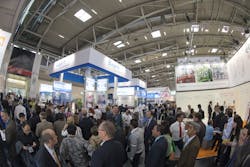IFAT 2016 to Explore Wastewater as Source of Energy
Wastewater, sewage gas and sewage sludge are three waste products that contain valuable heat energy that can be recovered. The latest waste-to-heat processes and technologies for use in water, wastewater and sludge treatment will be on show at the next IFAT, which takes place May 30 to June 3, 2016 at the Messe München exhibition center in Germany.
“Our exhibitors cover the entire technology spectrum from wastewater treatment to heat recovery and energy from wastewater,” said Silvia Fritscher, exhibition director of IFAT. “At their booths they also give best practice examples of new concepts for turning sewage plants into power stations.”
There is an abundance of energy in wastewater and its processing. For example, in sewage gas: In 2014, 1,340 GWh of electricity was generated from this byproduct of sewage sludge digestion in German sewage plants alone. This amount of energy can cover the electricity needs of a big city like Frankfurt am Main for an entire year. The potential here is much larger: There are more than 10,000 sewage plants in Germany, but last year only 1,252 of them were making use of sewage gas.
In the temperature of wastewater, also, there is a significant amount of energy. Depending on the application and time of measurement, domestic, commercial and industrial wastewater is between 10°C and 60°C. This energy treasure trove can be tapped into by passing this wastewater via special heat exchangers. Huber SE of Berching, Germany, a company specializing in machinery for water, wastewater and sludge treatment, has calculated that, for example, the capital of Bavaria—Munich—could in theory meet more than 60% of its energy needs by exploiting the heat in its own wastewater.
A practical and very useful way of tapping into this potential is to set up a small-scale recovery cycle. For example, in 2014 the sterile supplies department at the Rechts der Isar Hospital in Munich became the first such department in Germany to be fitted with a wastewater heat recovery system. Each year 64,000 pieces of equipment are cleaned and sterilized here; this represents most of the material needed in operations at the hospital. These processes generate a lot of hot wastewater, most of the heat from which is now recovered and re-used to prewarm the water for the next cleaning and sterilization processes. The amount of heat energy thus saved is around 200 MWh per year.
Recovery of heat from wastewater also works in an industrial environment, as illustrated by a process installed by Pharmaserv, an operator of industrial parks, in January 2015 at the Behringwerke in Marburg. There the wastewater is taken from a neutralization basin and directed into a new-style heat-exchanger system. The physical process inside the heat pump raises the temperature to around 60°C—energy that is then available, for example, for heating the building. Now, after the test phase has finished, it is clear that more than 6 MWh of heat per year can be made available in this way. Final implementation of the project is scheduled for 2016/2017.
“For many years the heat-exchanger technologies and large-scale heat pumps needed for heat-from-wastewater applications have had a firm place in the product spectrum of IFAT and the leading companies exhibiting there," Fritscher said. "Munich is the place to get a first look at technological innovations and new concepts.”
Source: IFAT
